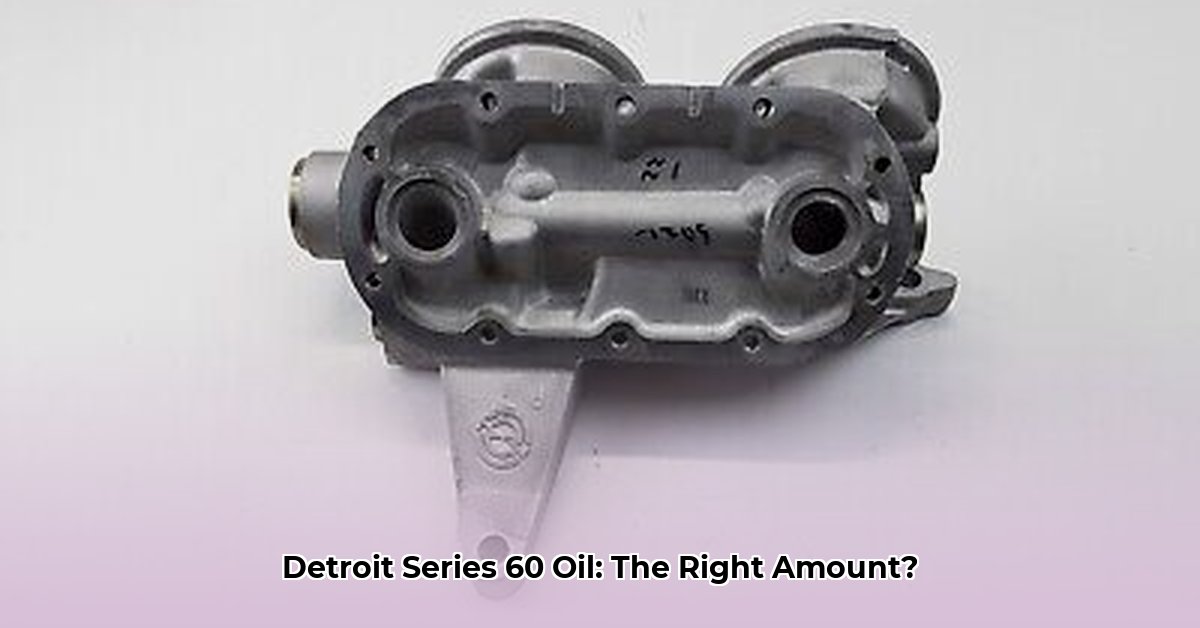
Understanding Detroit Series 60 Oil Capacity
Maintaining peak performance in your Detroit Series 60 engine necessitates a thorough understanding of its oil requirements. This guide provides a comprehensive overview of oil capacity, selection, and change intervals, emphasizing best practices for optimal engine health. Ignoring these factors can lead to significant engine damage and costly repairs.
Engine Size and Corresponding Oil Capacity
The Detroit Series 60 engine is available in three primary sizes: 11.1 liters, 12.7 liters, and 14 liters. The required oil capacity varies depending on the engine size:
- 11.1 Liter Engine: Typically requires 38 quarts of oil.
- 12.7 Liter Engine: Typically requires 40 quarts of oil.
- 14.0 Liter Engine: Typically requires 40 quarts of oil.
This difference reflects the increased lubrication needs of the larger engines due to their increased number of moving parts. Always verify the exact capacity in your owner's manual, as minor variations may exist depending on the year and specific engine configuration. Why is this capacity so critical? Insufficient oil leads to increased friction, overheating, and ultimately, engine failure.
Choosing the Right Oil: API Certification and Viscosity
Selecting the correct oil type is as crucial as knowing the quantity. Many Detroit Series 60 engines benefit from using a 10W-40 oil certified to API CH-4 standards. This certification ensures the oil meets rigorous industry requirements for performance and protection under various operating conditions. How does this certification matter? It ensures the oil's ability to withstand high temperatures and pressures, providing essential lubrication and preventing engine wear.
However, severe climate conditions may necessitate a different viscosity. During extremely cold weather, a 5W-30 or 10W-30 might be more suitable. Always consult your owner's manual for the recommended oil grade based on your geographic location and typical operating temperature range. Neglecting this can impact engine starting, lubrication, and overall engine life.
Detroit Series 60 Oil Change Intervals: A Practical Guide
Regular oil changes are paramount for maintaining engine health. The frequency of these changes depends largely on factors such as driving conditions and the type of fuel used.
Factors Influencing Oil Change Intervals
Several factors influence how often you should change your oil:
- Driving Conditions: Frequent stop-and-go city driving necessitates more frequent changes (e.g., every 6,000 miles) compared to highway driving (e.g., potentially every 15,000 miles).
- Fuel Type: The use of Ultra-Low Sulfur Fuel (ULSF) can influence oil degradation rates, necessitating careful consideration of adjustments to oil change intervals.
- Operating Conditions: Extreme temperatures, heavy loads, or use in emergency vehicles might warrant even more frequent oil changes.
Always consult your owner's manual for the manufacturer's recommended interval as a starting point. However, these recommendations are general guidelines; individual circumstances often require adjustments.
Ultra-Low Sulfur Fuel (ULSF): Considerations and Adjustments
The widespread transition to Ultra-Low Sulfur Fuel (ULSF) has introduced a new variable into oil maintenance. While environmentally beneficial, ULSF may subtly alter oil degradation patterns. While not necessarily causing faster degradation, it might necessitate a recalibration of the change interval. This is why regular monitoring is crucial.
This is where oil analysis becomes invaluable. It allows for proactive adjustments to the oil change schedule, enabling optimal efficiency and minimizing engine wear. This data-driven approach ensures that oil changes are done at the most appropriate time, maximizing both engine health and cost-effectiveness.
Step-by-Step Oil Change Procedure
This procedure assumes basic mechanical aptitude. Always consult your owner's manual for detailed instructions specific to your engine model and year. Improper maintenance voids warranties.
Safety First: Ensure your engine is cold and parked on a level surface. Engage the parking brake.
Gather Supplies: Acquire the correct amount and type of oil, a new oil filter, a drain pan, and wrenches.
Locate the Drain Plug: Identify the engine oil drain plug (refer to your owner's manual).
Drain the Old Oil: Carefully loosen and remove the drain plug, allowing the oil to drain completely into the pan.
Replace the Oil Filter: Locate the oil filter and replace it with a new one. Lubricate the new filter gasket to ensure a proper seal.
Replace the Drain Plug: Reinstall the drain plug, tightening it to the manufacturer's specified torque.
Add New Oil: Carefully add the correct amount of new oil, checking the dipstick frequently until it reaches the "full" mark.
Check for Leaks: Inspect the drain plug and filter for leaks.
Start the Engine: Briefly start the engine and check for any leaks.
Check Oil Level: Turn off the engine and double-check the oil level.
Key Takeaways: Maintaining Optimal Engine Performance
- Regular oil changes, guided by your owner's manual and operational conditions, are crucial for Detroit Series 60 engine longevity.
- Using the correct oil viscosity and API-certified oil is vital for proper lubrication and engine protection.
- Understanding the impact of ULSF on oil change intervals and utilizing oil analysis enables more precise and efficient maintenance.
- Always prioritize safety and consult your owner's manual for specific instructions.
This guide provides essential information; however, it is not a replacement for professional advice. Consult a qualified mechanic for any complexities or doubts related to your engine maintenance. Consistent, informed maintenance is your best investment in sustaining your Detroit Series 60 engine’s performance and longevity.